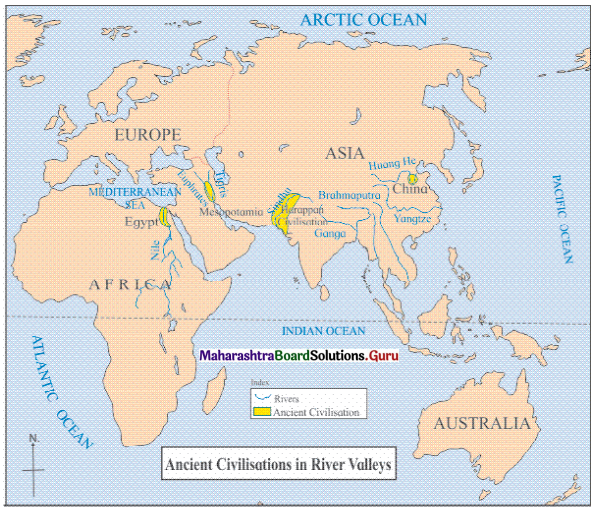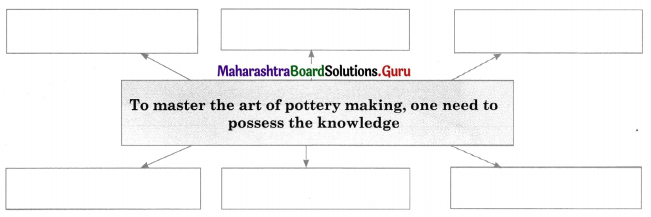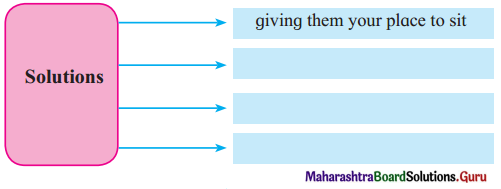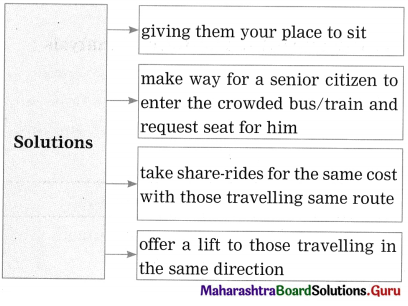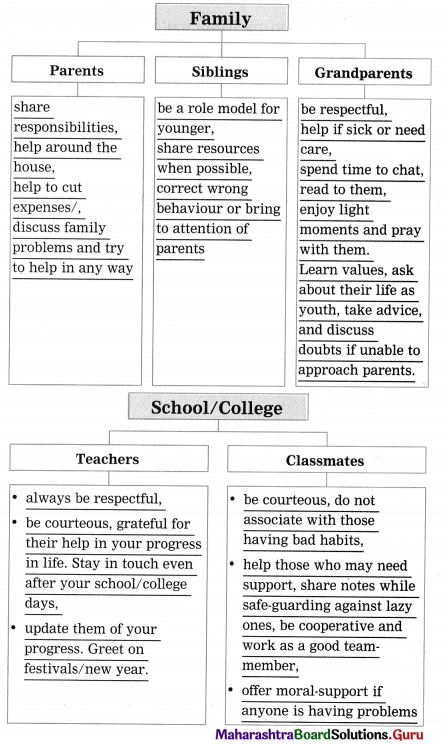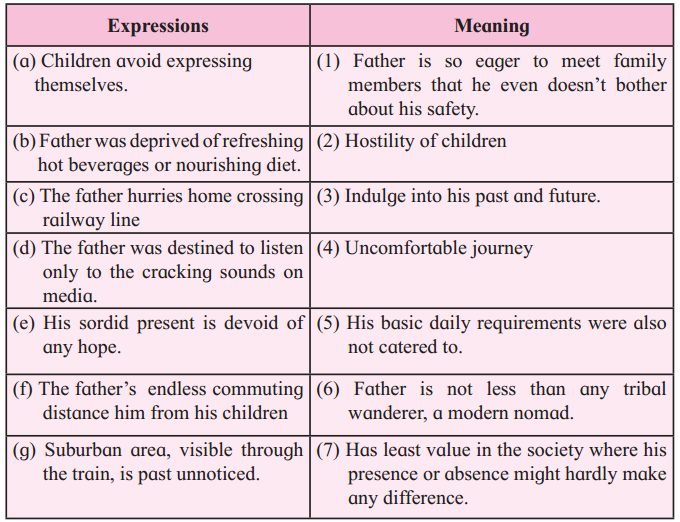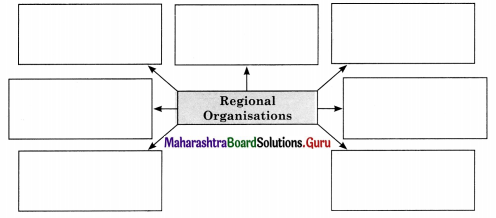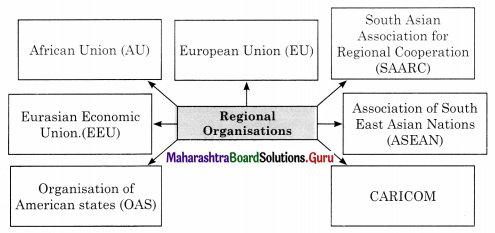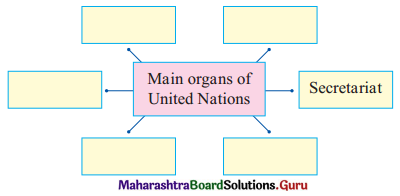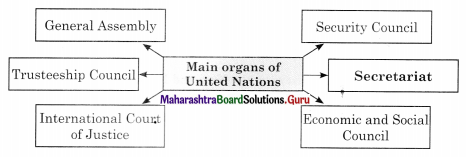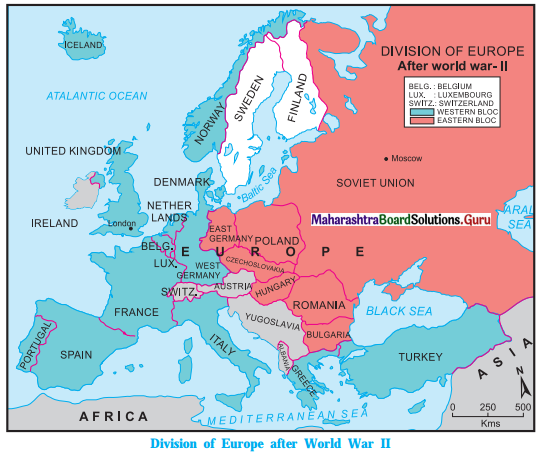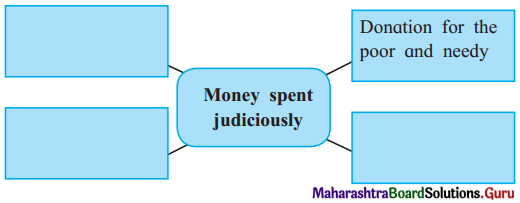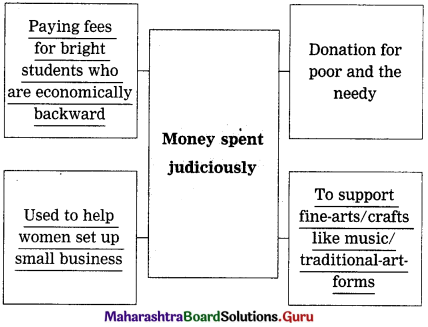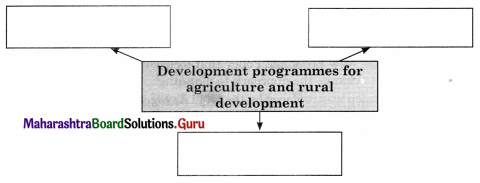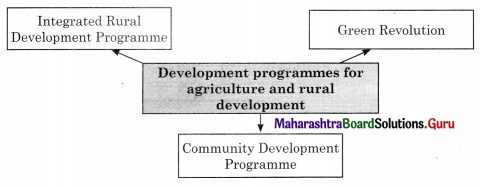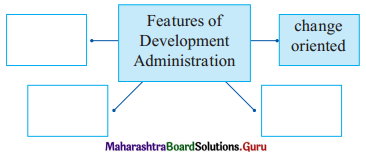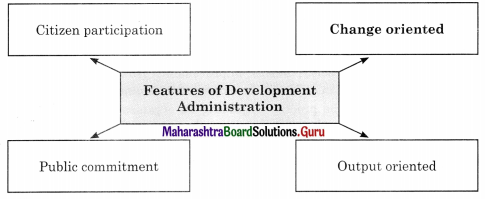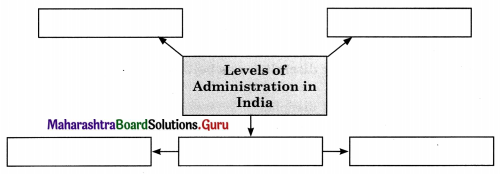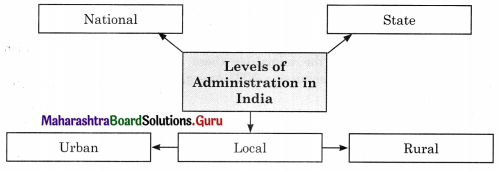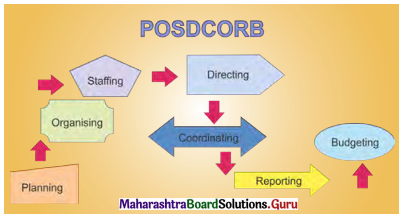Balbharti Maharashtra State Board Class 11 History Important Questions Chapter 2 First Cities of India Important Questions and Answers.
Maharashtra State Board 11th History Important Questions Chapter 2 First Cities of India
1A. Choose the correct alternative and write the complete sentences.
Question 1.
The __________ empire was founded in 2334 B.C.E. by Emperor Sargon I.
(a) Egyptian
(b) Akkadian
(c) Meluhhan
(d) Mesopotamian
Answer:
(b) Akkadian
Question 2.
__________ is the largest Harappan site among all the sites from India and Pakistan.
(a) Lothal
(b) Dholavira
(c) Gulf of Kutch
(d) Rakhigarhi
Answer:
(d) Rakhigarhi
![]()
Question 3.
__________ was a small city compared to Harappa and Mohenjodaro.
(a) Kalibangan
(b) Lothal
(c) Dholavira
(d) Chahanudaro
Answer:
(a) Kalibangan
Question 4.
Lothal was excavated by __________
(a) J. P. Joshi
(b) S. R. Rao
(c) R. D. Banerjee
(d) Madho Swarup
Answer:
(b) S. R. Rao
Question 5.
__________ is described as Purandara.
(a) Agni
(b) Varuna
(c) Indra
(d) Vayu
Answer:
(c) Indra
1B. Find the incorrect pair from set B and write the correct ones.
Question 1.
| Set ‘A’ | Set ‘B’ |
| (a) Kalibangan | Bikaner |
| (b) Mohenjodaro | Lothal |
| (c) Dholavira | Gujarat |
| (d) Rakhigarhi | Haryana |
Answer:
(b) Mohenjodaro – Pakistan
Question 2.
| Set ‘A’ | Set ‘B’ |
| (a) Vedic Aryans arrived in India | 1500 B.C.E |
| (b) Discovery of Harappa | 1931 |
| (c) Discovery of Mohenjodaro | 1922 |
| (d) Total Area covered | 1500000 |
Answer:
(b) Discovery of Harappa – 1921
![]()
Question 3.
| Set ‘A’ | Set ‘B’ |
| (a) Pre-Harappan Cultures | Cultures of the period preceding the Harappan civilisation |
| (b) Early Harappan period | Late Harappan phase |
| (c) Mature (Urban) Harappan period | The fully developed phase of Harappan civilisation |
| (d) Late Harappan period | The period after the decline of the mature (Urban) phase |
Answer:
(b) Early Harappan period – Early (beginning) Harappan phase
1C. Find the odd one out.
Question 1.
History of Harappan cities:
(a) Early Harappan
(b) Mature Harappan
(c) Vedic Period
(d) Late Harappan
Answer:
(c) Vedic Period
Question 2.
An archaeologist who excavated Harappan culture:
(a) Sir Alexander Cunningham
(b) Charles Masson
(c) R.K. Banerjee
(d) Sir John Marshall
Answer:
(b) Charles Masson
Question 3.
Harappan Period Sea trade route.
(a) Dilmun
(b) Makan
(c) Meluhha
(d) Lothal
Answer:
(d) Lothal
![]()
Question 4.
Religious centers of Harappa:
(a) Mohenjodaro
(b) Lotha
(c) Dholavira
(d) Kalibangan
Answer:
(c) Dholavira
2A. Write the names of historical places, persons, and events.
Question 1.
The city is situated on the banks of the river Ravi in Punjab, Pakistan.
Answer:
Harappa
Question 2.
British traveler who visited and wrote about archaeological remains at Harappa.
Answer:
Charles Masson
Question 3.
First Director-General of the Archaeological Survey of India.
Answer:
Sir Alexander Cunningham
Question 4.
Discovery of Harappa.
Answer:
1921
Question 5.
Excavations at Mohenjodaro.
Answer:
Rakhaldas Banerjee
Question 6.
Remains of Harappan dock in Gujarat.
Answer:
Lothal
Question 7.
Harappan settlement of Shortugai.
Answer:
Badakshan, Afghanistan
Question 8.
Mesopotamian temples.
Answer:
Ziggurats
![]()
2B. Choose the correct reason and complete the sentence.
Question 1.
The ancient civilisations of Mesopotamia and Harappa had cultural ties with each other because of __________
(a) fortifications
(b) the similarity between seals and artifacts
(c) public monuments were found
(d) impressive town planning
Answer:
(b) the similarity between seals and artifacts
Question 2.
The evidence of the first excavations at Harappa had indicated __________
(a) the first settlement of the Early Harappan period was established around 3300 B.C.E
(b) the city of Harappa was divided into two parts – the ‘Citadel’ and the ‘Lower Town’.
(c) internal changes begin to appear in Harappan cities.
(d) the decline of Harappan civilisation.
Answer:
(b) the city of Harappa was divided into two parts – the ‘Citadel’ and the ‘Lower Town’
Question 3.
The first settlement of the Early Harappan period was established __________
(a) around 2500 B.C.E
(b) around 2500 – 2800 B.C.E
(c) around 2600 B.C.E
(d) around 3300 B.C.E
Answer:
(d) around 3300 B.C.E
2C. Write the correct chronological order.
Question 1.
(a) Vedic Aryans
(b) Late Harappan period
(c) Mature Harappan period
(d) Early Harappan period
Answer:
(a) Early Harappan period
(b) Mature Harappan period
(c) Late Harappan period
(d) Vedic Aryans
![]()
Question 2.
(a) Mature (Urban) Harappan period
(b) Early Harappan period
(c) Post Harappan cultures
(d) Late Harappan period
Answer:
(a) Early Harappan period
(b) Mature (Urban) Harappan period
(c) Late Harappan period
(d) Post Harappan cultures
Question 3.
(a) Discovery of Harappa
(b) Excavation of Dholavira
(c) Excavation of Lothal
(d) Discovery of Mohenjodaro
Answer:
(a) Discovery of Harappa (1921)
(b) Discovery of Mohenjodaro (1922)
(c) Excavation of Lothal (1995 – 1960)
(d) Excavation of Dholavira (1990)
[Note: Years in a bracket are only given for understanding]
3. Observe the map on page 13 of your textbook and answer the following questions based on it.
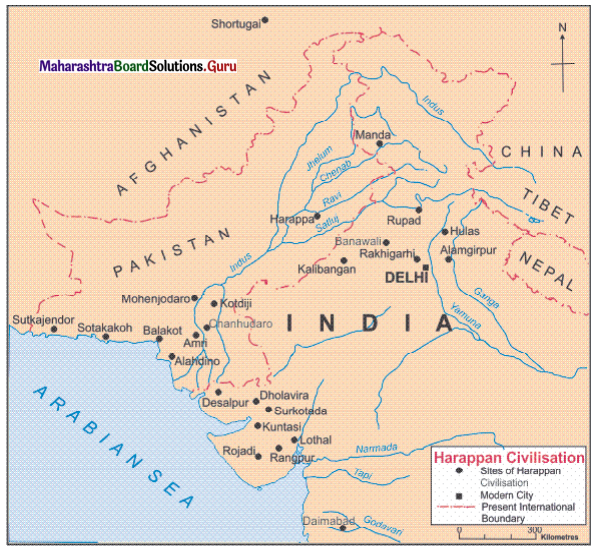
Question 1.
Point out some of the Harappan sites in India.
Answer:
Some of the Harappan sites in India are Kalibangan, Dholavira, Surkotda, Lothal, Rangpur.
Question 2.
Point out the Harappan sites in modern-day Pakistan.
Answer:
Harappan sites in modern day Pakistan are Mohenjodaro, Harappa, Chahnudaro, Balakot.
Question 3.
Point out the only Harappan site in Afghanistan.
Answer:
The only Harappan site in Afghanistan is Shortugai.
![]()
Question 4.
Point out the modern city of India.
Answer:
The modern city of India – Delhi.
Question 5.
Near which river Daimabad is located?
Answer:
Daimabad is located near Godavari River.
4. Complete the concept maps.
Question 1.

Answer:

Question 2.
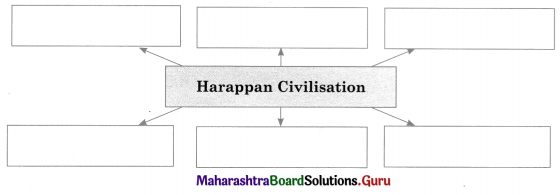
Answer:

Question 3.

Answer:

![]()
Question 4.

Answer:

5. Write short notes.
Question 1.
Lothal
Answer:
- Lothal was excavated from 1955 to 1960 under the supervision of S.R. Rao.
- It is situated near the Gulf of Kutch in Gujarat, 80 km away from Ahmedabad.
- It is known for the remains of the Harappan dock.
- The ‘Citadel’ and the ‘Lower Town’ at Lothal are surrounded by a single fortification wall.
- Lothal was established on the banks of the river Bhogao.
- The presence of platforms built for stalls, a warehouse, and the dock confirm that Lothal was an important port and trading center. Lothal is an example of the engineering excellence of ancient people.
Question 2.
Lapis Lazuli Stone
Answer:
- Lapis Lazuli a semi-precious stone was found in the region of Badakshan province of Afghanistan, ‘Shortugai’.
- This region is rich with mines of lapis lazuli.
- There was a great demand for this stone in Mesopotamia.
- The Mesopotamian epics describe Goddess Inanna’s palace, the walls of which were embedded with this stone.
- This Stone was a very important commodity in the Harappan trade with Mesopotamia.
Question 3.
Ziggurats
Answer:
- Mesopotamian temples are known as ‘ziggurats’.
- The administrative system of the Mesopotamian Cities revolved around the administration of these temples.
- The high priest of the temple used to be the ruler of the city.
- The social life, cultural events, Power and hierarchy of officials, etc were organized in accordance with the rituals and festivals of the presiding deity of the temple.
Question 4.
Rakhigarhi
Answer:
- The Hissar district of Haryana has situated the site of Rakhigarhi, a Harappan city.
- It is at a distance of 150 kilometers from Delhi.
- It is located on the banks of Chautang (ancient Drishdvati river).
- Rakhigarhi is the largest Harappan site, among all the sites from India and Pakistan.
- Its total area was more than 350 Hectares. The excavations at Rakhigarhi started in 1963.
- It continued in 1997-2000. Later, Dr. Vasant Shinde of the Deccan College, Pune also conducted excavations at the site.
![]()
Question 5.
Harappan Sites
Answer:
- Many sites of the Early Harappan and Mature Harappan (Urban) phases have been found in the basin of the river Ghaggar.
- The latest research based on the evidence from sites like Kunal, Bhirrana, Farman, Girwad, and Mitathal, etc. indicates a possibility of the rise of the Mature Harappan more than 5000 years ago.
- The Harappan sites of Mohenjodaro, Harappa, Ganweriwala in Pakistan, and Rakhigarhi and Dholavira in India have been declared as World Heritage sites.
6. State your opinion.
Question 1.
The river known as ‘Ghaggar Hakra’ flows only during the monsoon.
Answer:
- River Gjaggar Hakra originates in the Siwalik Hills in Himachal Pradesh and flows to Rajasthan through Punjab and Haryana.
- From there it enters the Desert of Cholistan in Pakistan. Ultimately it enters the Rann of Kutch.
- It is known as Ghaggar in India and as Hakra in Pakistan. Its bed remains dry through the year except during the monsoon.
- Thus, a river known as ‘Ghaggar Hakra’ flows only during the monsoon.
7. Answer the following questions in detail.
Question 1.
Explain the interrelationship between cities and villages in the Harappan Civilisation.
Answer:
- The Harappan people depended on natural resources and villages in the vicinity in order to meet the needs of the urban way of life and urban administration.
- The raw material needed for industrial production included clay, various siliceous and semi¬precious stones, metals, etc.
- The interrelationship between Harappan cities and villages was dependent on the mechanism of making available things like food grains and raw materials.
- There was a network of small towns, small and big villages and campsites of semi-nomadic people which functioned to cater to the needs of major urban centers of the Harappan civilization.
- The best example of it is the Harappan Settlement of Shortugai.
Question 2.
Write in detail on Mesopotamian temples, ‘Ziggurats’.
Answer:
- Mesopotamia is known for its grand temples.
- The administrative system of Mesopotamian cities revolved around the administration of these temples.
- Mesopotamian temples are known as ‘ziggurats’.
- The high priest of the temple used to be the ruler of the city.
- The social life, cultural events, power and hierarchy of officials, etc were organized in accordance with the ritual and festival of the presiding deity of the temple.
- The notion of a ‘priest king’ of the Harappan civilisation was formulated by presuming its close similarity with the Mesopotamian culture.
![]()
Question 3.
Reasons for the decline of cities.
Answer:
The reasons for the decline of cities are as follows:
- It is known that the Harappan civilisation began to decline around 2000 – 1900 B.C.E.
- People had to regret elsewhere with the beginning of the later Harappan Period.
- The Harappan trade with Mesopotamia was on the decline in the late Harappan Period because the Mesopotamia economy had weakened.
- A deteriorating environment was the main reason for the decline of Mesopotamia.
- Similarly, climatic changes and deteriorating environment were the main reason for the decline of the Harappan civilisation too.
- The late Harappan people were forced to migrate became of natural calamities.
- New villages were settled by the Nature Harappan and Late Harappan people wherever they went.
- The Harappan civilization deteriorated as the cumulative effect of various factors such as a decline in trade, climatic changes, weakening of two economies.
8. Answer the following questions with the help of given points.
Question 1.
Write about some cities of Harappa with the help of the following points:
(a) Harappa
(b) Mohenjodaro
(c) Kalibangan
(d) Lothal
(e) Dholavira
(f) Rakhigarhi
Answer:
(a) Harappa:
- Harappa is situated on the banks of the river Ravi (District Sahiwal in Punjab, Pakistan).
- The ancient site of Harappa had spread on 150 Hectares.
- The first excavation at Harappa began in 1921. The first settlement of the Early Harappan Period was established around 3300 B.C.E.
- It evolved to the Mature Harappan (urban) phase around 2600 B.C.E. It reached its peak during 2450-1900 B.C.E.
![]()
(b) Mohenjodaro:
- Mohenjodaro was built on the banks of the river Sindhu (Indus) in Pakistan (District Larkana, Sindh).
- Area-wise, Mohenjodaro is the biggest city, among those discovered in Pakistan so far.
- It was thought that the city was divided into two fortified sections, namely the ‘Citadel’ and the ‘Lower Town’.
- The excavations at Mohenjodaro by Rakhaldas Banerjee began in 1921-22.
- In 1923- 24 to gather more information about Mohenjodaro Madho Sarup Vats, Kashinath Narayan Dikshit, Ernest Mackay, and others conducted further excavations under Sir John Marshall’s direction.
- He was the Director-General of the Archaeological Survey of India at that time.
- During these excavations, various artifacts, houses, and public monuments were unearthed.
(b) Kalibangan:
- The site of Kalibangan is 205 kilometers away from Bikaner. It is located in the Hanumangarh district of Rajasthan.
- It was one of the important urban centers of the Harappan civilisation, situated on the banks of the river Ghaggar.
- L. P. Tessitore, an Italian linguist had visited Kalibangan during his study tour of the region. It was conducted under the direction of Brijabasi Lai, the then Director-General of the Archaeological Survey of India, and Balkrishna Thapar.
- At Kalibangan two settlements, one of the Mature Harappan period and the other of the Early Harappan period, were found. Kalibangan was a small city compared to Harappa and Mohenjodaro.
(c) Lothal:
- Lothal was established on the bank of the river Bhogao.
- The center of the Harappan civilisation at Lothal was situated near the Gulf of Kutch, in Gujarat, 80 kilometers away from Ahmedabad.
- It is known for the remains of Harappan dock.
- Lothal was excavated from 1955 to 1960 under the supervision of S.R. Rao. The ‘Citadel’ and the ‘Lower Town’ at Lothal do not have separate fortification walls.
- Rather, they are surrounded by a single fortification wall.
(d) Dholavira:
- Dholavira was discovered by J.P. Joshi, the Director-General of Archaeological Survey of India. The site is in ‘Khadirbet’ in Gujarat (Dist. Kutch).
- Excavations at the site were started by R.S. Bisht in 1990.
- Among the excavated Harappan sites, extent wise Dholavira is the fifth-largest city.
- An Early Harappan settlement was discovered at Dholavira.
- There was a protective wall built around it by using mud bricks (unbaked bricks) and dressed stones. It was surrounded by an outer fortification wall.
- The settlement within the outer fortification was divided into four sections.
- Citadel
- The adjacent section reserved for high officials
- Lower Town – These three sections had walls, which separated them from each other.
- The fourth section inside the outer fortification did not have any additional separating walls.
![]()
(e) Rakhigarhi:
- The Hissar district of Haryana has situated at the site of Rakhigarhi, a Harappan city.
- It is at a distance of 150 kilometers from Delhi.
- It is located on the banks of Chautang (ancient Drishdvati river).
- Rakhigarhi is the largest Harappan site, among all the sites from India and Pakistan.
- Its total area was more than 350 Hectares.
- The excavations at Rakhigarhi started in 1963. It continued in 1997-2000.
- Later, Dr. Vasant Shinde of the Deccan College, Pune also conducted excavations at the site.
